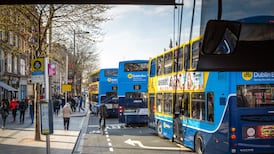Shares in US ride-hailing company Lyft jumped more than 20 per cent above their initial public offering price on Friday, opening at $87.24 per share (€77.65).
Some 6.1 million shares changed hands when the stock began trading on the Nasdaq in New York.
Lyft’s initial public offering raised $2.3 billion on Thursday at an issue price of $72 a share, valuing the company at $24 billion on a fully diluted basis.
It was the largest US technology IPO since Snap in 2017, boosting hopes for a wave of listings by the most highly valued private companies in Silicon Valley, including Pinterest, Slack, Airbnb, and the biggest so-called unicorn of all, Uber.
Enthusiasm
Lyft beat its arch-rival to market, but Uber is close behind. The company is preparing to unveil its own IPO as soon as next month, according to sources. Investors and bankers say it could be valued at more than $100 billion in one of the biggest public offerings in US corporate history.
Lyft co-founders Logan Green and John Zimmer said the decision to take the company public had been driven by the company’s internal readiness, not Wall Street enthusiasm.
“We thought the moment to do it was when we could go public without changing the day-to-day way we ran the company,” Mr Zimmer, Lyft’s president, told the Financial Times in an interview. “It happened to be that this a good moment in the market to do so.”
He said the response was a validation for Lyft’s long-term goal of replacing private cars with a shared and, eventually autonomous, fleet.
“Investors were excited to be part of this story because they saw there is a massive shift coming from owned vehicles to transportation as a service,” he said. “We’ve seen this play out in entertainment with Netflix and Spotify. They agree with us that there’s never been a market this large make that shift.”
Investors flocked to Lyft despite its steep losses since it was founded in 2012 as a spin-off of Mr Green and Mr Zimmer’s first venture, a Facebook app for long-distance carpooling.
In its marketing roadshow over the past two weeks, the company pitched its rapid growth in revenue and market share, as well as the expansion of the overall ride-hailing market, as a can’t-miss investment opportunity.
Losses
Lyft and Uber have battled each other in the US from their earliest days, driving up losses. But Lyft took advantage when Uber was rocked by a series of scandals in 2017, boosting its market share to about 30 per cent today, according to research group Second Measure. It still spends heavily, however, with losses rising 32 per cent to $911 million last year as revenue doubled to $2.16 billion.
Lyft sold 32.5 million shares at $72 each, the top end of its targeted range. The offering was “meaningfully oversubscribed”, according to a person familiar with the matter, leading the company to increase both its price range and number of shares on sale. JPMorgan Chase led the listing with Credit Suisse and Jefferies.
Lyft kicked off its first day as a public company on Friday at a former car dealership in Los Angeles, where its co-founders rang the bell to open trading on the Nasdaq more than 2,000 miles away.
Rather than travelling to Nasdaq in New York, Lyft marked the occasion in Los Angeles, the hometown of chief executive Mr Green, who said the city’s notorious traffic had convinced him car ownership is a “failing model” and inspired his interest in rethinking transportation. Los Angeles is the ride-hailing app’s largest metropolitan market.
The founders were joined by Lyft board members and staff as well as Nasdaq president Nelson Griggs at a former Toyota dealership that Lyft is converting into a driver centre where it will offer repairs and other services. The company also invited some longtime drivers and passengers to the event.
Los Angeles mayor Eric Garcetti was also on hand as Lyft announced it would invest at least $50 million a year in transportation initiatives in cities where it operates, starting with LA. Measures include providing free and discounted rides to people in need, adding more bikes and scooters to the Lyft network, building electric vehicle charging stations and buying renewable energy credits.
“Some good came out of Los Angeles traffic,” Mr Garcetti said. – Copyright The Financial Times Limited 2019












